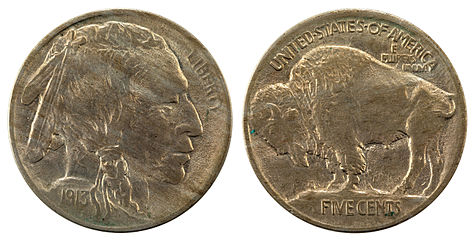Indian Head nickel
| United States | |
| Value | 5 cents (.05 US dollars) |
|---|---|
| Mass | 5.000 g |
| Diameter | 75mm mm (0.8350 in) |
| Edge | Plain |
| Composition | |
| Years of minting | 1913–1938 |
| Mint marks | D, S. Centered under "FIVE CENTS" on the reverse. Philadelphia Mint specimens lack mint mark. |
| Obverse | |
|
|
|
| Design | Right profile of an American Indian |
| Designer | James Earle Fraser |
| Design date | 1913 |
| Design discontinued | 1938 |
| Reverse | |
|
|
|
| Design | An American bison |
| Designer | James Earle Fraser |
| Design date | 1913 |
| Design discontinued | 1913 |
|
|
|
| Designer | James Earle Fraser |
| Design date | 1913 |
| Design discontinued | 1938 |
The Buffalo nickel or Indian Head nickel is a copper-nickel five-cent piece that was struck by the United States Mint from 1913 to 1938. It was designed by sculptor James Earle Fraser.
As part of a drive to beautify the coinage, five denominations of US coins had received new designs between 1907 and 1909. In 1911, Taft administration officials decided to replace Charles E. Barber's Liberty Head design for the nickel, and commissioned Fraser to do the work. They were impressed by Fraser's designs showing a Native American and an American bison. The designs were approved in 1912, but were delayed several months because of objections from the Hobbs Manufacturing Company, which made mechanisms to detect slugs in nickel-operated machines. The company was not satisfied by changes made in the coin by Fraser, and in February 1913, Treasury Secretary Franklin MacVeagh decided to issue the coins despite the objections.
Despite attempts by the Mint to adjust the design, the coins proved to strike indistinctly, and to be subject to wear—the dates were easily worn away in circulation. In 1938, after the expiration of the minimum 25-year period during which the design could not be replaced without congressional authorization, it was replaced by the Jefferson nickel, designed by Felix Schlag. Fraser's design is admired today, and has been used on commemorative coins and the gold American Buffalo series.
In 1883, the Liberty Head nickel was issued, featuring designs by Mint Engraver Charles E. Barber. After the coin was released, it was modified to add the word "CENTS" to the reverse because the similarity in size with the half eagle allowed criminals to gild the new nickels and pass them as five dollar coins. An Act of Congress, passed into law on September 26, 1890 required that coinage designs not be changed until they had been in use 25 years, unless Congress authorized the change. The act made the current five-cent piece and silver dollar exceptions to the twenty-five year rule; they were made eligible for immediate redesign. However, the Mint continued to strike the Liberty Head nickel in large numbers through the first decade of the 20th century.
...
Wikipedia


